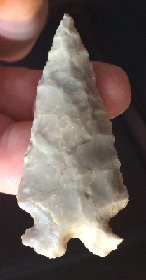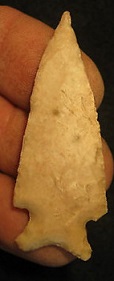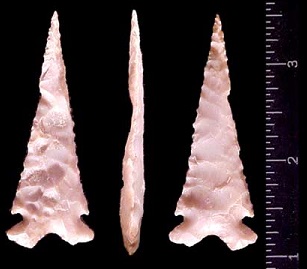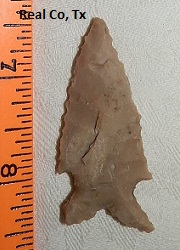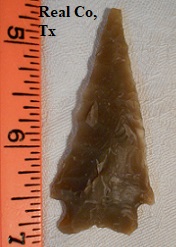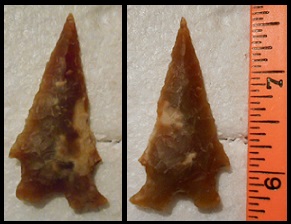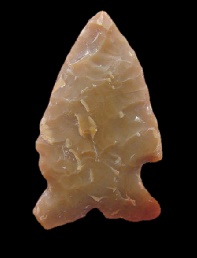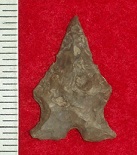Outline is Representative of Size and Shape:

Name Details:
Identified By: E. O. Miller / Edward B. Jelks
Named For:
Date Identified: 1952
Type Site: Belton Reservoir, Coryell County, Texas
Identified By: E. O. Miller / Edward B. Jelks
Named For:
Date Identified: 1952
Type Site: Belton Reservoir, Coryell County, Texas
Point Validity:
Collector type
Most examples of this type are professionally classified as Frio type points (see additional comments). This type has many collector source references and is considered a collector type.
Most examples of this type are professionally classified as Frio type points (see additional comments). This type has many collector source references and is considered a collector type.
Ensor Split Base
AKA: Ensor FrioCollector Type
Cluster:
Description of Physical Characteristics and Flaking Pattern:
This is a thin medium to large triangular corner notch point with a flattened cross section. The blade may vary from excurvate to straight. Re-sharpened examples may have an incurvate or recurvate blade. The shoulders are primarily barbed, but may take on a horizontal appearance especially in re-sharpened examples. The stem is broad, expanding and usually the same width as the shoulders. The base may vary from having a bifurcated form or V notch to having a center basal notch. This point has a random flaking pattern.
Size Measurements:
Total Length - 30 to 70 mm (average 50 mm), Stem Length - 6 to 11 mm, Width at shoulders - 20 to 30 mm, Neck Width - 13 to 18 mm, Stem Width - 20 to 28 mm
Total Length - 30 to 70 mm (average 50 mm), Stem Length - 6 to 11 mm, Width at shoulders - 20 to 30 mm, Neck Width - 13 to 18 mm, Stem Width - 20 to 28 mm
Commonly Utilized Material:
Additional Comments:
Dan R. Davis (1991), divides these points into three sub-categories which include: Type I - Concave Base, Type II - Slight Convex Base, and Type III - Straight Base. Davis does not recognize the split stem variety.
Both Ensor and Frio type points were originally classified as Ensor points at Belton Reservoir by Miller and Jelks. Suhm et el (1954) re-defined the Ensor type excluding the Frio points from the definition of the Ensor type. Many collector sources consider Frio type points associated with Ensor points as Ensor Split Stem or Ensor Frio points. The primary difference between the Ensor Frio and the Frio type is that the Ensor Frio has a narrow diagonal notch with a slightly barbed shoulder and a recurvate base while the Frio type has a wider parallel notch with a shoulder that is generally at a slight upward angle and a base that is notched or having a V appearance. However, the two types are related and the difference between the two types may represent a continuum of the same type which is why this type has not been accepted professionally as a true type.
This point has two forms, the first has more of a V notch base and many consider the Ensor Split Base (Picture 1). The other form is a basal notch in the center basal notch which many consider a Ensor Frio point (Picture 2).
Dan R. Davis (1991), divides these points into three sub-categories which include: Type I - Concave Base, Type II - Slight Convex Base, and Type III - Straight Base. Davis does not recognize the split stem variety.
Both Ensor and Frio type points were originally classified as Ensor points at Belton Reservoir by Miller and Jelks. Suhm et el (1954) re-defined the Ensor type excluding the Frio points from the definition of the Ensor type. Many collector sources consider Frio type points associated with Ensor points as Ensor Split Stem or Ensor Frio points. The primary difference between the Ensor Frio and the Frio type is that the Ensor Frio has a narrow diagonal notch with a slightly barbed shoulder and a recurvate base while the Frio type has a wider parallel notch with a shoulder that is generally at a slight upward angle and a base that is notched or having a V appearance. However, the two types are related and the difference between the two types may represent a continuum of the same type which is why this type has not been accepted professionally as a true type.
This point has two forms, the first has more of a V notch base and many consider the Ensor Split Base (Picture 1). The other form is a basal notch in the center basal notch which many consider a Ensor Frio point (Picture 2).
Distribution: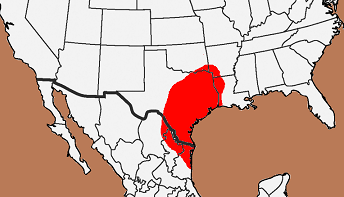

Distribution Comments:
This point is primarily found in from central Texas into the Lower Pecos River valley and throughout the Guadalupe River valley. This point is found with diminished frequency into the Sabine River Valley of eastern Texas and western Louisiana and into Arkansas and Oklahoma. Frequency diminishes into southern Tamaulipas.
This point is primarily found in from central Texas into the Lower Pecos River valley and throughout the Guadalupe River valley. This point is found with diminished frequency into the Sabine River Valley of eastern Texas and western Louisiana and into Arkansas and Oklahoma. Frequency diminishes into southern Tamaulipas.
Age / Periods:
Date: 2,200 - 1,400 B.P.
Cultural Period: Transitional Archaic
Glacial Period: Roman Warm
Culture:
Date: 2,200 - 1,400 B.P.
Cultural Period: Transitional Archaic
Glacial Period: Roman Warm
Culture:
Age Details:

